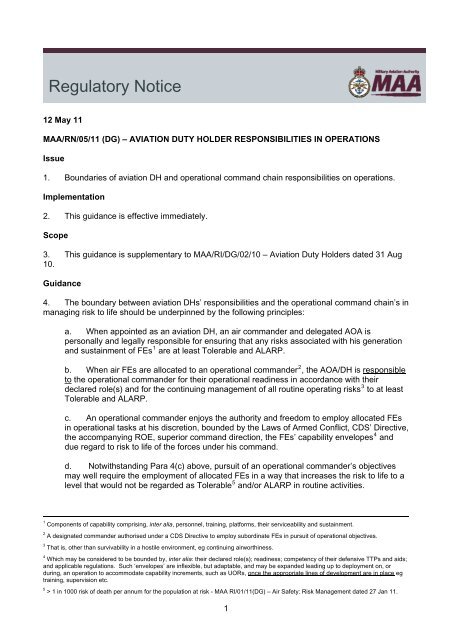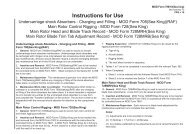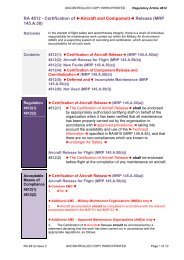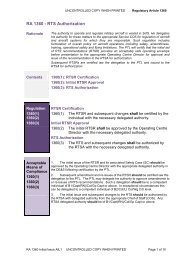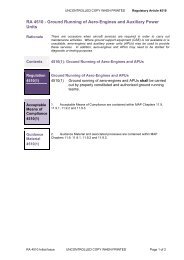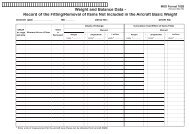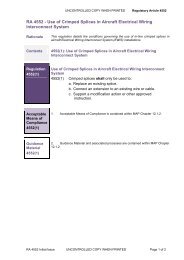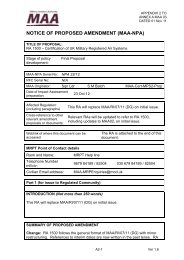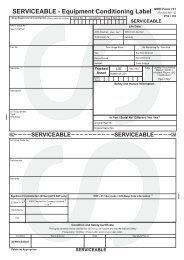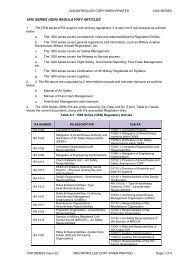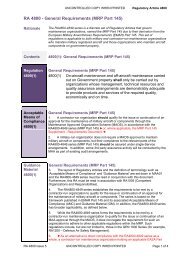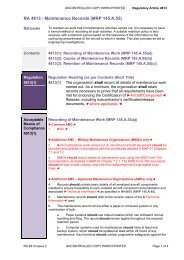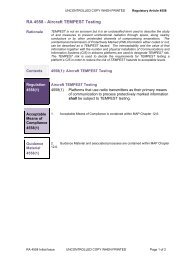MAA RN/05/11 - Military Aviation Authority
MAA RN/05/11 - Military Aviation Authority
MAA RN/05/11 - Military Aviation Authority
Create successful ePaper yourself
Turn your PDF publications into a flip-book with our unique Google optimized e-Paper software.
Regulatory Notice<br />
12 May <strong>11</strong><br />
<strong>MAA</strong>/<strong>RN</strong>/<strong>05</strong>/<strong>11</strong> (DG) – AVIATION DUTY HOLDER RESPONSIBILITIES IN OPERATIONS<br />
Issue<br />
1. Boundaries of aviation DH and operational command chain responsibilities on operations.<br />
Implementation<br />
2. This guidance is effective immediately.<br />
Scope<br />
3. This guidance is supplementary to <strong>MAA</strong>/RI/DG/02/10 – <strong>Aviation</strong> Duty Holders dated 31 Aug<br />
10.<br />
Guidance<br />
4. The boundary between aviation DHs’ responsibilities and the operational command chain’s in<br />
managing risk to life should be underpinned by the following principles:<br />
a. When appointed as an aviation DH, an air commander and delegated AOA is<br />
personally and legally responsible for ensuring that any risks associated with his generation<br />
and sustainment of FEs 1 are at least Tolerable and ALARP.<br />
b. When air FEs are allocated to an operational commander 2 , the AOA/DH is responsible<br />
to the operational commander for their operational readiness in accordance with their<br />
declared role(s) and for the continuing management of all routine operating risks 3 to at least<br />
Tolerable and ALARP.<br />
c. An operational commander enjoys the authority and freedom to employ allocated FEs<br />
in operational tasks at his discretion, bounded by the Laws of Armed Conflict, CDS’ Directive,<br />
the accompanying ROE, superior command direction, the FEs’ capability envelopes 4 and<br />
due regard to risk to life of the forces under his command.<br />
d. Notwithstanding Para 4(c) above, pursuit of an operational commander’s objectives<br />
may well require the employment of allocated FEs in a way that increases the risk to life to a<br />
level that would not be regarded as Tolerable 5 and/or ALARP in routine activities.<br />
1<br />
Components of capability comprising, inter alia, personnel, training, platforms, their serviceability and sustainment.<br />
2<br />
A designated commander authorised under a CDS Directive to employ subordinate FEs in pursuit of operational objectives.<br />
3<br />
That is, other than survivability in a hostile environment, eg continuing airworthiness.<br />
4<br />
Which may be considered to be bounded by, inter alia: their declared role(s); readiness; competency of their defensive TTPs and aids;<br />
and applicable regulations. Such ‘envelopes’ are inflexible, but adaptable, and may be expanded leading up to deployment on, or<br />
during, an operation to accommodate capability increments, such as UORs, once the appropriate lines of development are in place eg<br />
training, supervision etc.<br />
5<br />
> 1 in 1000 risk of death per annum for the population at risk - <strong>MAA</strong> RI/01/<strong>11</strong>(DG) – Air Safety: Risk Management dated 27 Jan <strong>11</strong>.<br />
1
e. Where employment 6 of air FEs in a manner that is likely to increase the risk to life<br />
beyond that which would be deemed Tolerable and/or ALARP for routine activities is<br />
premeditated 7 , the responsible operational commander must seek formally the advice of the<br />
relevant aviation DH 8 , or his senior representative 9 in Theatre, on the level of risk, potential<br />
mitigations and, if appropriate, alternative courses of action. Where this is not achieved, the<br />
DH’s representative(s) in Theatre shall make the DH aware. When, following due<br />
consideration and the application of any caveats or controls, an aviation DH actively<br />
endorses such an excursion, which may be time limited, the aviation DH thereby accepts and<br />
owns the associated risk. Notwithstanding, subject to Para 4(c) above, the freedom and<br />
authority to employ the allocated FEs in a manner of his choosing is ultimately retained by<br />
the operational commander 10 .<br />
f. Where operational imperatives demand urgent employment of air FEs in a manner that<br />
is likely to increase the risk to life beyond that which would be deemed Tolerable and/or<br />
ALARP for routine activities and prior consultation with the relevant DH, or his senior<br />
representative, is impractical, an operational commander retains the freedom and authority to<br />
employ the allocated FEs in a manner of his choosing. Clearly, in doing so, he must be<br />
prepared to justify his actions in retrospect, preferably via a context based and suitably<br />
tailored auditable risk analysis and decision making process <strong>11</strong> .<br />
5. Therefore, the limit of an aviation DH’s responsibility and accountability for managing<br />
risk to life in the operational domain is defined as the point at which an operational<br />
commander unilaterally directs any relevant activity 12 that transcends the Tolerable risk<br />
boundary set for routine operations, or involves risk that is not ALARP, be undertaken.<br />
6. To assist in developing and implementing the associated processes, aviation DHs are at<br />
liberty, and may find it useful, to appoint deployed Senior Operators (SO) and Chief Air Engineers<br />
(CAE) who are responsible respectively to their parent DHs for providing internal assurance of<br />
deployed operating procedures, standards and Flight Safety, and Engineering standards and<br />
practices. The responsibilities of a deployed SO or CAE are directly to the relevant aviation DH,<br />
but need not necessarily be exclusive to their assuming roles in the operational command chain.<br />
7. The implementation of the above principles will require exploitation of existing structures and<br />
processes, some of which may need to be adapted, and probably development of additional<br />
supporting mechanisms that will need to integrate and be coherent with extant arrangements. The<br />
DH’s <strong>Aviation</strong> Risk Register, ASSG and ASSWG processes are likely to fall in the former category,<br />
whilst the means by which operational commanders assess risk to life in the air domain and, when<br />
required, consult with DHs would benefit from further development by CJO and stakeholders.<br />
Acknowledging the constraints that might be imposed by the tempo of operations, the key to<br />
success will be early consultation and an established working dialogue between the operational<br />
command and DH chains.<br />
6<br />
Other than with regard to survivability in a hostile environment. Nevertheless, even in this regard, it might be considered prudent for<br />
an operational commander to seek the advice of the AOA/DH, or his senior representative in Theatre.<br />
7<br />
For practical purposes, consideration of a course of action more than 24 hours in advance should be considered premeditated.<br />
8<br />
Or, where extant regulations are likely to be infringed, the Regulator.<br />
9<br />
Subject to the level of risk under consideration, the lowest level of representation should be a SQEP OF4 personally authorised by the<br />
DH. Alternatively, for larger operations DHs may appoint a deployed SO and/or a CAE.<br />
10<br />
Where a substantive and significant difference of opinion between an aviation DH and an operational commander arises, the DH has<br />
the option to elevate his concerns to CJO, the NCC, or his SDH, all of whom have the option to refer the issue to CDS.<br />
<strong>11</strong><br />
It is acknowledged that the urgency of a particular situation may preclude some or all of such a process being carried out formally.<br />
Nevertheless, the principles of such a process should inform operational commanders’ judgements and be seen to have done so.<br />
12<br />
Operating and/or support.<br />
2
Sponsor<br />
8. The sponsor of this Notice is DG <strong>MAA</strong>. Queries should be addressed through:<br />
MA to DG <strong>MAA</strong><br />
Mil: 9621 82724<br />
Tel: 020 72 182724<br />
DIIF: <strong>MAA</strong>-DG MA<br />
Email: maa-dgma@mod.uk<br />
Reference Publications<br />
9. Changes to the MARDS and aviation related Defence Standards may be affected by the<br />
guidance in this Notice. Formal amendment to those documents is underway.<br />
Superseded Instructions<br />
10. No instructions are superseded.<br />
Review<br />
<strong>11</strong>. This notice will be reviewed on 01 Dec <strong>11</strong> unless explicitly rescinded or superseded prior to<br />
that date.<br />
3


